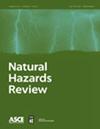美国太阳能发电的飓风风险
IF 2.2
3区 工程技术
Q3 ENGINEERING, CIVIL
引用次数: 0
摘要
预测显示,到2050年,太阳能将占美国总发电量的55%。尽管太阳能越来越重要,但很少有研究分析了由于飓风等极端天气事件在全国范围内部署太阳能基础设施的风险。本文提出了一个概率框架来评估太阳能基础设施在飓风期间发电的性能,飓风经常导致美国的严重停电。我们的新框架集成了最新的数据驱动模型,这些模型捕获了两个关键和复合因素:降低辐照度的瞬态云条件和可能导致永久性面板损坏的强风。我们将该框架应用于美国中部和东部38个州的2694个县,以阐明飓风期间太阳能发电的风险格局。我们的研究结果表明,飓风对美国的影响是显著的、复合的,而且明显不成比例。我们表明,在佛罗里达州和路易斯安那州,云层迅速将太阳能发电量分别减少到正常水平的32%和65%,恢复周期为100年。我们的研究结果还表明,电池板的损坏会在登陆后几天内导致更严重和永久的能量损失,特别是在罕见的风暴中,例如,在200年的事件中,登陆后两天造成的损失比飓风云多80%。摘要:一种模拟飓风期间太阳能发电的新方法显示,美国太阳能基础设施的环境风险景观存在显著的区域差异。本文章由计算机程序翻译,如有差异,请以英文原文为准。
Hurricane Risk of Solar Generation in the United States
Projections indicate that solar energy will constitute 55% of total electricity capacity by 2050 in the US. Despite solar energy’s growing importance, few studies have analyzed the risks of country-wide deployments of solar infrastructure due to extreme weather events such as hurricanes. This paper presents a probabilistic framework to evaluate the performance of solar infrastructure to generate energy during hurricanes, which often cause significant outages in the US. Our novel framework integrates recent data-driven models that capture two critical and compounding factors: transient cloud conditions that decrease irradiance and high winds that can cause permanent panel damage. We apply the framework to the 2694 counties in the 38 Central and Eastern US states to elucidate the risk landscape of solar generation during hurricanes. Our results show that hurricane impacts are significant, compounding, and strikingly disproportional in the US. We show that in Florida and Louisiana, clouds rapidly reduce solar generation to 32% and 65%, respectively, of their normal levels with a return period of 100 years. Our results also show that damage to panels can induce more acute and permanent energy losses a few days after landfall, especially in rarer storms, e.g., causing 80% more losses than hurricane clouds two days after landfall for 200-year events. Synopsis: A new methodology to model solar generation during hurricanes shows substantial regional variability in the environmental risk landscape of solar infrastructure in the US.
求助全文
通过发布文献求助,成功后即可免费获取论文全文。
去求助
来源期刊

Natural Hazards Review
ENGINEERING, CIVIL-GEOSCIENCES, MULTIDISCIPLINARY
CiteScore
4.90
自引率
7.40%
发文量
72
审稿时长
3 months
期刊介绍:
The Natural Hazards Review addresses the range of events, processes, and consequences that occur when natural hazards interact with the physical, social, economic, and engineered dimensions of communities and the people who live, work, and play in them. As these conditions interact and change, the impact on human communities increases in size, scale, and scope. Such interactions necessarily need to be analyzed from an interdisciplinary perspective that includes both social and technical measures. For decision makers, the risk presents the challenge of managing known hazards, but unknown consequences in time of occurrence, scale of impact, and level of disruption in actual communities with limited resources. The journal is dedicated to bringing together the physical, social, and behavioral sciences; engineering; and the regulatory and policy environments to provide a forum for cutting edge, holistic, and cross-disciplinary approaches to anticipating risk, loss, and cost reduction from natural hazards. The journal welcomes rigorous research on the intersection between social and technical systems that advances concepts of resilience within lifeline and infrastructure systems and the organizations that manage them for all hazards. It offers a professional forum for researchers and practitioners working together to publish the results of truly interdisciplinary and partnered approaches to the anticipation of risk, loss reduction, and community resilience. Engineering topics covered include the characterization of hazard forces and the planning, design, construction, maintenance, performance, and use of structures in the physical environment. Social and behavioral sciences topics include analysis of the impact of hazards on communities and the organizations that seek to mitigate and manage response to hazards.
 求助内容:
求助内容: 应助结果提醒方式:
应助结果提醒方式:


